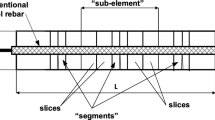Abstract
A probabilistic model developed by the authors, of the fibers distribution in a reinforced concrete element has been verified in a series of tests described in this paper. The tests comprised twelve square cross-section bars made of fiber reinforced concrete with standard deformed rebars of different diameters, located at their center, as well as three specimens without conventional reinforcement. Each specimen was sawed into equal slices, where the width of each slice was equal to the length of a single fiber, and the fibers were counted. The statistical analysis included calculation of the average value and standard deviation of a non-dimensional variable, defined as the ratio between the actual and average volumes of steel, that of the rebars and of the steel fibers, in a typical segment of the bar. It was shown that there is a good agreement between the linear prediction of the standard deviation assumed by the model and the values obtained from the statistical analysis of the fibers count. Such assumption is not trivial and the empirical results prove its validity, which was not obvious prior to the tests. A good agreement was also obtained between the cumulative distribution functions predicted by the model and obtained from the count.





Similar content being viewed by others
References
International Federation for Structural Concrete (fib) SAG 5 (2013) Model Code for concrete structures 2010. Wilhelm Ernst & Shon
ACI Committee 318 (2014) Building code requirements for structural concrete (ACI 318-14) and commentary. American Concrete Institute, Farmington Hills
Vandewalle L (2000) Cracking behaviour of concrete beams reinforced with a combination of ordinary reinforcement and steel fibers. Mater Struct 33:164–170
Wafa FF, Ashour SA (1992) Mechanical properties of high-strength fiber reinforced concrete. ACI Mater J 89(5):449–455
Balendran RV, Zhou FP, Nadeem A, Leung AYT (2002) Influence of steel fibres on strength and ductility of normal and lightweight high strength concrete. Build Environ 37(12):1361–1367
Balaguru PN, Shah SP (1992) Fiber reinforced cement composites. McGraw-Hill, New York
Schumacher P, Walraven JC, den Uijl JA (2009) Rotation capacity of self-compacting steel fibre reinforced concrete beams. Heron 54(2/3):127–162
Redaelli D (2006) Testing of reinforced high performance fibre concrete members in tension. In: Proceedings of the 6th international PhD symposium in civil engineering. Zurich, Switzerland, pp 122–123
Deluce JR, Vecchio FJ (2013) Cracking of SFRC members containing conventional reinforcement. ACI Struct J 110(3):481–490
Redaelli D, Muttoni A (2007) Tensile behaviour of reinforced ultra-high performance fiber reinforced concrete element. In: Proceedings of the fib symposium concrete structures: stimulators of development. Dubrovnik, Croatia, pp 267–274
Dancygier AN, Savir Z (2006) Flexural behavior of HSFRC with low reinforcement ratios. Eng Struct 28(11):1503–1512
Dancygier AN, Berkover E (2016) Cracking localization and reduced ductility of fiber-reinforced concrete beams with low reinforcement ratios. Eng Struct 111:411–424
Dancygier AN, Karinski YS (2014) Probabilistic model of the crack localization in axially loaded fibrous reinforced concrete bars. Eng Struct 79:417–426
Martinie L, Roussel N (2011) Simple tools for fiber orientation prediction in industrial practice. Cem Concr Res 41(10):993–1000
Soroushian P, Lee CD (1990) Distribution and orientation of fibers in steel fiber reinforced concrete. ACI Mater J 87:433–439
Dupont D, Vandewalle L (2005) Distribution of steel fibers in rectangular sections. Cem Concr Compos 27:391–398
Eik M (2014) Orientation of short steel fibres in concrete: measuring and modelling. Doctoral Dissertation, Aalto University publication series, Helsinki, Finland
Gettu R, Gardner DR, Saldivar H, Barragan BE (2005) Study of the distribution and orientation of fibers in SFRC specimens. Mater Struct 38:31–37
Ferrara L, Faifer M, Muhaxheri M, Toscani S (2011) A magnetic method for non-destructive monitoring of fiber dispersion and orientation in steel fiber reinforced cementitious composites. Part 2: Correlation to tensile fracture toughness. Mater Struct 45(4):591–598
Ozyurt N, Mason TO, Shah SP (2006) Non-destructive monitoring of fiber orientation using AC-IS: an industrial-scale application. Cem Concr Res 36(9):1653–1660
Suuronen JP, Kallonen A, Eik M, Puttonen J, Serimaa R, Herrmann H (2013) Analysis of short fibres orientation in steel fibre reinforce concrete (SFRC) using X-ray tomography. J Mater Sci 48(3):1358–1367
Głodkowska W, Kobaka J (2013) Modelling of properties and distribution of steel fibres within a fine aggregate concrete. Constr Build Mater 44:645–653
Bentur A, Mindess S (2007) Fibre reinforced cementitious composites, 2nd edn. Taylor & Francis, London
Acknowledgements
This work was supported by a joint grant from the Centre for Absorption in Science of the Ministry of Immigrant Absorption and the Committee for Planning and Budgeting of the Council for Higher Education under the framework of the KAMEA Program and by the Ministry of Construction and Housing. The research grants are greatly appreciated. The authors would like to thank also Eng. S. Engel, Eng. V. Eisenberg and Dr. I. Leviathan for their useful advice and support.
Author information
Authors and Affiliations
Corresponding author
Rights and permissions
About this article
Cite this article
Karinsrki, Y.S., Dancygier, A.N. & Navon, Z. Experimental verification for a probabilistic model of fibers distribution along a reinforced concrete bar. Mater Struct 50, 119 (2017). https://doi.org/10.1617/s11527-016-0987-1
Received:
Accepted:
Published:
DOI: https://doi.org/10.1617/s11527-016-0987-1




